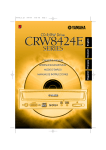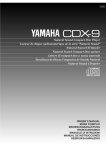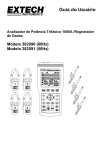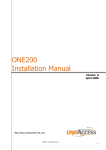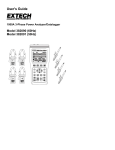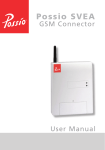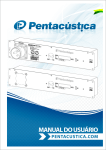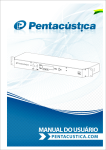Download Musical Fidelity Tri-Vista Specifications
Transcript
TRI-VISTA SACD UPSAMPLING 24 BIT SUPER AUDIO COMPACT DISC PLAYER NEXT PREV OPEN CLOSE PLAY PAUSE STOP EXTERNAL INPUT POWER MUSICAL FIDELITY INSTRUCTIONS FOR USE Thank you for purchasing the Musical Fidelity Tri-Vista SACD 24 bit Super Audio Compact Disc Player. Used properly and carefully, it should give many years of outstanding musical reproduction. This model uses the latest 24 Bit DAC technology and jitter reduction techniques to achieve both an excellent technical specification and unparalleled sound quality. Aesthetically, the Tri-Vista SACD is a perfect match for the Tri-Vista 300 Integrated or Super Pre-amp which are part of our 20th Anniversary series. Together these components form one of the finest hi-fi systems available. Dust regularly with a soft duster or soft brush, but be careful when using cleaning or polishing agents - they may harm the surface finish. If you have any questions about your audio system, please consult your dealer who is there to help and advise. Issue 4: March 2003 Tri-Vista SACD Instructions for Use Page 1 of 16 CONTENTS PAGE 3 Safety Information: - Mains plug (U.K. only) Modification warning 4 Safety Information: - Laser product labelling 5 User Information: - Laser type Radio-frequency interference 6 General Advice: - Installation precautions User information 7 Introduction: - Introduction Notes on using compact discs Cleaning Installation 8 Facilities and Connections: - Panel illustrations 9 Remote Control: - Operation and illustration 10 Connections: - Output connections Input connections 11 Basic Operation: - Starting Loading Playing discs Pause function Stop 12 Basic Operation: (continued) - Track selection Search Displaying playback time 13 Special Functions: - Repeat playback A-B repeat playback Shuffle playback Introduction scan 14 Special Functions: (continued) - Using digital inputs SACD audio format selection Display brightness 15 Problems ? : - Basic problem solving 16 Specifications Issue 4: March 2003 Tri-Vista SACD Instructions for Use Page 2 of 16 SAFETY INFORMATION IMPORTANT! (U.K. only) This unit is supplied in the U.K. with a mains lead fitted with a moulded 13 amp plug. If, for any reason, you need to cut off the plug, please remove the fuse holder and dispose of the plug safely, out of reach of children. It must not be plugged into a mains outlet. The wires in the mains lead supplied with this appliance are coloured in accordance with the following code: Green and yellow Blue Brown Earth Neutral Live WARNING - This appliance must be earthed As the colours of the wires of the mains lead of this appliance may not correspond with the coloured markings identifying the terminals in your plug, proceed as follows: The wire which is coloured green-and-yellow must be connected to the terminal in the plug which is marked with the letter E or coloured green or green-and-yellow, or by the earth symbol: The wire which is coloured brown must be connected to the terminal which is marked with the letter L or coloured red. The wire which is coloured blue must be connected to the terminal which is marked with the letter N or coloured black. If connecting to a BS1363 plug, a 13 amp fuse must be used. WARNING: ANY MODIFICATIONS TO THIS PRODUCT NOT EXPRESSLY APPROVED BY MUSICAL FIDELITY WHO IS THE PARTY RESPONSIBLE FOR STANDARDS COMPLIANCE COULD VOID THE USER'S AUTHORITY TO OPERATE THIS EQUIPMENT. Issue 4: March 2003 Tri-Vista SACD Instructions for Use Page 3 of 16 SAFETY INFORMATION CLASS 1 LASER PRODUCT This SACD player has been designed and manufactured according to FDA regulations "title 21, CFR, chapter 1, subchapter J, based on the Radiation Control for Health and Safety Act of 1968", and is classified as a Class 1 laser product. There is no hazardous radiation during normal use because invisible radiation emitted inside this product is completely confined within the protective housing. However you must observe the following important warnings: CAUTION ! • THIS SACD PLAYER USES INVISIBLE LASER LIGHT. WHEN THE PLAYER OPERATES, LASER LIGHT IS RADIATED INTERNALLY. DO NOT REMOVE THE PROTECTIVE HOUSINGS. • USE OF CONTROLS OR ADJUSTMENTS OR PERFORMANCE OF PROCEDURES OTHER THAN THOSE SPECIFIED HEREIN MAY RESULT IN HAZARDOUS RADIATION EXPOSURE CAUSING EYE INJURY. • IF THIS PRODUCT DEVELOPS A FAULT, PLEASE CONTACT YOUR AUTHORISED MUSICAL FIDELITY SERVICE AGENT. DO NOT ATTEMPT TO SERVICE IT YOURSELF AND DO NOT CONTINUE TO USE THIS PRODUCT IN A FAULTY STATE. WARNING AND INFORMATION LABELS: THIS PRODUCT COMPLIES WITH DHHS RULES 21 CFR, CHAPTER 1, SUBCHAPTER J, PART 1040 AT DATE OF MANUFACTURE. THIS PRODUCT COMPLIES WITH PART 15 OF THE FCC RULES. OPERATION IS SUBJECT TO TWO CONDITIONS: 1 THIS DEVICE MAY NOT CAUSE HARMFUL INTERFERENCE, AND 2 THIS DEVICE MUST ACCEPT ANY INTERFERENCE RECEIVED, INCLUDING INTERFERENCE THAT MAY CAUSE UNDESIRED OPERATION. AUDIO OUTPUT RIGHT CAUTION EXTERNAL DIGITAL OUTPUT LEFT EXTERNAL DIGITAL INPUT MOUNT UNIT ON SOLID SURFACE. DO NOT REMOVE SCREWS OR COVERS UNDER ANY CIRCUMSTANCES. NO USER SERVICEABLE COMPONENTS INSIDE. REFER SERVICING TO QUALIFIED ENGINEER. SEE OWNERS MANUAL FER FURTHER INFORMATION. THIS PRODUCT COMPLIES WITH DHHS RULES 21 CFR. CHAPTER 1, SUBCHAPTER J, PART 1040 AT DATE OF MANUFACTURE THIS PRODUCT COMPLIES WITH PART 15 OF THE FCC RULES. OPERATION IS SUBJECT TO TWO CONDITIONS. 1. THIS DEVICE MAY NOT CAUSE HARMFUL INTERFERENCE, AND 2. THIS DEVICE MUST ACCEPT ANY INTERFERENCE RECEIVED, INCLUDING INTERFERENCE THAT MAY CAUSE UNDESIRED OPERATION COAXIAL COAXIAL OPTICAL OPTICAL CLASS 1 LASER PRODUCT POWER CONSUMPTION 50W DATE OF MANUFACTURE SERIAL NUMBER THIS APPLIANCE MUST BE EARTHED CC Label fitted internally to metal plate above CD mechanism Issue 4: March 2003 Tri-Vista SACD 50/60Hz IMPORTANT CAUTION - VISIBLE AND INVISIBLE LASER RADIATION WHEN OPEN. AVOID EXPOSURE TO BEAM. ADVARSEL - SYNLIG OG USYNLIG LASERSTRÅLING VED ÅBNING UNDGÅ UDSETTELSE FOR STRÅLING. ADVARSEL - SYNLIG OG USYNLIG LASERSTRÅLING NÅR DEKSEL APNES UNNGÅ EKSPONERING POR STRÅLEN. VARNING -- SYNLIG OCH OSYNLIG LASERSTRÄLNING NÄR DENNA DEL ÄR ÖPPNAD BETRAKTA EJ STRALEN. VARO !- AVATTAESSA OLET ALTTINA NÄKYVÄLLE JA NÄKYMÄTTÖMÄLLE LASER SÄTAILYLLE ÄLÄ KATSO SÄTEESEEN. VORSICHT ! - SICHTBARE UND UNSICHTBARE LASERSTRAHLUNG WENN ABDECKUNG GEÖFFNET. NICHT DEM STRAHL AUSSETZEN! DANGER VISIBLE AND INVISIBLE LASER RADIATION WHEN OPEN. AVOID DIRECT EXPOSURE TO BEAM. ATTENTION RAYONNEMENT LASER VISIBLE ET INVISIBLE EN CAS D’OUVERTURE EXPOSITION DANGEREUSE AUFAISCEAU. Instructions for Use Page 4 of 16 USER INFORMATION LASER INFORMATION: Optical pick-up: Manufacturer: Laser type: Beam divergence: Wavelength: Output power: Semiconductor GaAlAs 60° 780nm 10mW RADIO - FREQUENCY INTERFERENCE (RFI) This equipment uses and can radiate radio frequency energy, and if not installed and operated in accordance with the instructions, may cause interference to radio communications. However, it is designed to radiate minimal levels of RFI, and accordingly been testing to North American standards (FCC regulations - limits for a class B digital device persuant to part 15 of the rules). These requirements are intended to provide reasonable protection against excessive interference in a residential installation. Conversely, the product has also been checked to ensure that its own operation is not adversely affected by normal background levels of RFI received externally. However, if interference is experienced, for instance to radio or TV broadcasts, the user is recommended to try one or more of the following measures: • Identify the source of interference by turning off power to the SACD player or other equipment individually, and checking whether the problem disappears. • Re-orientate or relocate the receiving aerial. • Move the SACD player away from the receiver. • Connect the SACD player to a mains outlet on a different circuit from the receiver. • Consult a dealer or experienced TV/radio technician for help. If a problem persists, please contact Musical Fidelity's service department. Issue 4: March 2003 Tri-Vista SACD Instructions for Use Page 5 of 16 GENERAL ADVICE INSTALLATION PRECAUTIONS and USER INFORMATION Your new Tri-Vista SACD is designed and built to provide trouble-free performance, but as with all electronic devices it is necessary to observe a few precautions: Heed all warnings shown on the back of the product. Only connect the Tri-Vista SACD to a mains outlet having the same voltage as marked at the back of the unit. Always ensure that when disconnecting and reconnecting your audio equipment the mains supply is switched off. Position the mains lead and signal interconnects where they are not likely to be walked on or trapped by items placed on them. Do not use near water, or place water-filled containers on the SACD player, for example flower vases or potted plants. If water does spill inside, immediately pull out the mains plug from the wall socket and inform your dealer, who should then check the unit before further use. Entry of liquid into the player is dangerous, and may cause electric shock or fire hazard. Do not place the unit near direct heat sources such as radiators, direct sunlight or other equipment. Do not remove any covers or try to gain access to the inside. There are no internal user adjustments. Refer all service work to an authorised Musical Fidelity agent. NOTE: Unauthorised opening of the equipment will invalidate any warranty claims. There are fuses inside the Tri-Vista SACD. In the unlikely event that one blows, refer the unit to your audio dealer. Do NOT try to replace the fuse yourself as this will invalidate the warranty. Dust regularly with a soft duster or soft brush but be careful when using cleaning or polishing agents - they may harm the surface finish. The electronics in modern hi-fi equipment is complex and may, therefore, be adversely affected or damaged by lightning. For protection of your audio system during electrical storms, remove the mains plugs and disconnect any aerial lead. The remote control enables most functions of the SACD player to be operated from a convenient distance. Several of the features described in this manual are only available via the remote handset. Do not dispose of used batteries in a fire. If after-sales service is required, to help your dealer identify the Tri-Vista SACD player please quote the serial number located on the rear panel of the unit. Issue 4: March 2003 Tri-Vista SACD Instructions for Use Page 6 of 16 INTRODUCTION INTRODUCTION CLEANING Congratulations on the purchase of your new Tri-Vista SACD upsampling 24 BIT SACD player. Before cleaning the SACD player, always turn off the power at the mains switch and remove the mains plug from the wall outlet. Clean the housing and the remote control unit using a moist cloth. We do not advise the use of solvents, white spirits or thinners, as they could damage the surface finish of the unit. This model uses the latest technology for the reproduction of both your CD and SACD collections. The digital data stream is first up-sampled to 192kHz, which moves noise, jitter and distortion artefacts well above the audio band. It is then passed through a new, low noise, low distortion 24-bit digital-to-analog convertor operating at 192kHz, which allows simpler filtering of the analog output. This in turn gives an improved audio response without the need for sharp filters that degrade sound quality. The result is a CD player which gives a smoother response than previously possible with none of the “hardness” of other players. The Tri-Vista SACD is part of our 20th Anniversary series (SACD, Tri-Vista 300 Integrated, Super Pre and Super Power) and when used with any of these will give results that are as good as it gets. INSTALLATION Position the SACD player on a stable, horizontal surface where there is no risk of it being knocked, or subjected to vibration such as from loudspeakers. Protect your SACD player from humidity if the unit is moved from a cold place to a warm room, moisture can form on the pickup lens inside the player, preventing the laser beam from reading the disc. If this happens, remove the SACD, close the disc drawer, and leave the unit switched on for an hour or so to allow sufficient time for the moisture to evaporate. NOTES ON USING DISCS Always hold CDs or SACDs by the edges and make sure they remain clean. Do not touch the surface, or stick paper or adhesive tape to either side of the disc. Keep them away from direct sunlight and heat sources, such as radiators. Do not leave discs in a car parked in direct sunlight, as the temperature inside the car can become extremely high. Clean with a cloth before playing them, but do not use solvents, such as benzene, thinners, commercially available cleaners or antistatic spray intended for analogue records. After playing, always return the disc to its case for storage. Issue 4: March 2003 Tri-Vista SACD Instructions for Use Page 7 of 16 FACILITIES AND CONNECTIONS NEXT PREV OPEN CLOSE PLAY PAUSE STOP EXTERNAL INPUT POWER MUSICAL FIDELITY 1 2 3 5 4 6 7 8 9 10 11 1 FRONT PANEL 1 6 7 8 9 10 11 Disc transport loading drawer Disc player display (incorporates infra-red remote control receiver) PLAY to start disc playback PAUSE to interrupt playback STOP to end disc playback External input indicator LED 15 16 17 DIGITAL OUTPUT, optical DIGITAL INPUT, optical IEC type mains inlet Illuminated feet with multi-colour indicator LEDs for power and mute POWER mains on/off switch PREVious track selector NEXT track selector OPEN/CLOSE to open and close the disc drawer 2 3 4 5 REAR PANEL 12 13 14 DIGITAL OUTPUT, co-axial DIGITAL INPUT, co-axial AUDIO OUTPUTS, left and right, RCA 12 13 14 AUDIO OUTPUT RIGHT CAUTION EXTERNAL DIGITAL OUTPUT LEFT EXTERNAL DIGITAL INPUT MOUNT UNIT ON SOLID SURFACE. DO NOT REMOVE SCREWS OR COVERS UNDER ANY CIRCUMSTANCES. NO USER SERVICEABLE COMPONENTS INSIDE. REFER SERVICING TO QUALIFIED ENGINEER. SEE OWNERS MANUAL FER FURTHER INFORMATION. THIS PRODUCT COMPLIES WITH DHHS RULES 21 CFR. CHAPTER 1, SUBCHAPTER J, PART 1040 AT DATE OF MANUFACTURE THIS PRODUCT COMPLIES WITH PART 15 OF THE FCC RULES. OPERATION IS SUBJECT TO TWO CONDITIONS. 1. THIS DEVICE MAY NOT CAUSE HARMFUL INTERFERENCE, AND 2. THIS DEVICE MUST ACCEPT ANY INTERFERENCE RECEIVED, INCLUDING INTERFERENCE THAT MAY CAUSE UNDESIRED OPERATION COAXIAL COAXIAL OPTICAL OPTICAL CLASS 1 LASER PRODUCT POWER CONSUMPTION 50W DATE OF MANUFACTURE SERIAL NUMBER THIS APPLIANCE MUST BE EARTHED CC 15 Issue 4: March 2003 16 Tri-Vista SACD 50/60Hz IMPORTANT 17 Instructions for Use Page 8 of 16 REMOTE CONTROL Remote control buttons shown below enable disc player functions to be operated from a convenient distance. Remaining buttons on this universal handset are for use with other Musical Fidelity products, and have no effect on the Tri-Vista SACD player. Equivalent buttons on the remote handset have the same functions as those on the front panel of the unit. SEARCH and special functions (see pages 13 and 14) are only available by remote control. As the handset uses an invisible infra-red light beam, the front edge must be pointed directly towards the receiver window at the front of the player, without visual obstruction between them. If the range of the remote control greatly decreases, replace the batteries with new ones. Do not mix old and new batteries - two are required, type SUM-4, AAA or LR03. REMOTE CONTROL (Disc functions only) 1 OPEN/CLOSE disc tray 2 External digital input selector (see page 14) 3 SACD / CD layer selector (see page 14) 4 Direct track access buttons 5 Special function buttons - see pages 13 and 14 6 SEARCH buttons to scan forwards or backwards 7 TRACK back/forwards buttons (equivalent to PREVious and NEXT buttons on player front) 8 STOP to end disc playback 9 PAUSE to halt disc playback temporarily 10 PLAY to begin disc play or resume play after pausing Issue 4: March 2003 Tri-Vista SACD 2 3 1 4 5 7 6 8 9 10 Instructions for Use Page 9 of 16 CONNECTIONS BEFORE CONNECTING . . . . . . . MAINS POWER CONNECTION Ensure that mains power to the various components of your audio system is switched off. Please note that audio connecting leads are not supplied with this product. Finally, insert the accessory IEC mains lead plug into the rear panel socket, then the other end into a convenient wall outlet, and switch the power on. OUTPUT CONNECTION The Tri-Vista SACD should be connected to an analogue amplifier input by audio cables with RCA/phono type plugs. These link the left and right AUDIO OUTPUT sockets on the rear panel of the CD player to corresponding line input sockets on the amplifier. Do not use any sockets on the amplifier intended for “vinyl” phono cartridge input, as the sensitive circuit will overload, producing a severely distorted sound. Alternatively, the DIGITAL OUTPUTS (coaxial or optical) can be used for connection to suitable digital equipment. All three types of output can be used for feeding different equipment at the same time, if required. INPUT CONNECTION The internal D-to-A convertor will also convert digital data from any PCM (SPDIF) source to analog audio, but not data from AC3, Minidisc, or MP3 formats. Digital inputs are therefore provided for one of two sources, optical or co-axial - see page 14. Do not connect both co-axial and optical leads at the same time. However, if this is done accidentally, the first input connected will take priority in operation. Issue 4: March 2003 Tri-Vista SACD Instructions for Use Page 10 of 16 BASIC OPERATION STARTING . . . . DISC PLAY Press the POWER button on the Tri-Vista SACD player. If PLAY is pressed, the display will briefly show “PCM 2/0” to confirm that the disc loaded is a Compact Disc, or “DSD 2/0” if the disc is an SACD. Note that these indications will only appear the first time either type of disc is loaded and played. The LEDs in the feet of the unit will light red for about fifteen seconds indicating that all outputs from the unit are muted. Feet illumination then fades over approximately five seconds to amber, indicating that output is no longer muted, and that your Tri-Vista SACD player is now ready for use. However, after a further period of about 35 minutes, the colour fades to blue, confirming that the player has fully warmed up. LOADING AND PLAYING DISCS If mains power to the Tri-Vista SACD player is switched on with a disc already loaded, it will automatically read the disc and display the total number of tracks available on it, and total playing time, for example: However, if no disc is loaded, the unit will display “READ” then “SACD”. To play a disc, press the OPEN/CLOSE button to open the transport drawer. When the drawer is fully extended, insert the required disc with the label facing upwards and then press either the OPEN/CLOSE or PLAY button to close the transport drawer again. If OPEN/CLOSE has been pressed, the disc drawer closes and the player scans the contents of the disc. After a short delay, the display window then shows the total number of tracks available, and total playing time, as in the previous example: Issue 4: March 2003 Tri-Vista SACD The unit will then begin playing, and current track and remaining track time will be displayed similar to the following example: (If an SACD is being played, SACD appears instead of CD to the left of the display). When all tracks on the disc have been played, playback stops and the display reverts to the same track content and total playing time indication as when first loaded. PAUSE Pressing the PAUSE button whilst a disc is playing interrupts playback of the disc. A pause symbol ( ll ) appears in the display window between track number and time indication: The disc will continue spinning but the track does not advance and the Tri-Vista SACD's output is muted. Pressing PLAY again resumes playback from the same place. STOP playback can be stopped at any time by pressing the STOP button once. Instructions for Use Page 11 of 16 BASIC OPERATION TRACK SELECTION To change track, briefly press the track skip buttons NEXT or PREVious to jump forwards or backwards one track in either direction. Note that a single press of the PREVious button restarts playback at the beginning of the current track. A double-press is needed to jump back to the previous track. Corresponding TRACK buttons on the remote control are also marked |<< and >>|. If either button is held down for more than about two seconds, the Tri-Vista SACD will not jump tracks, but instead enter search mode (see below), skipping approximately 4 or 5 seconds of playing time in the appropriate direction. To revert to normal playback, press PLAY again. As the unit searches through a track, the track time display (far right digits) will be seen to advance rapidly in the required direction by approximately 4 or 5 second play intervals. Press the PLAY button to return to normal playback. DISPLAYING PLAYBACK TIME There are two playback time display modes obtained alternately by pushing the TIME button on the remote control. The normal mode (e.g. after switch on) shown below indicates the elapsed time for the currently playing track: (1 minute 23 seconds in this example). TRACK SELECTION (Remote control) A specific track can be selected directly by pressing the required track number button on the remote control. The chosen track then plays immediately. To play a track number with two digits, the second digit must be pressed within one second of pressing the first button. Pushing the TIME button once changes the display to show the remaining time for the current track: (30 mins 13 seconds in this example). Pushing the TIME button again reverts the display to show elapsed time. SEARCH The SEARCH buttons can be used to fastforward or fast-rewind during playback in a similar way to a video or tape cassette player, allowing location of particular passages at high speed. When using this function, CD playback remains audible, but not when searching on SACD. Briefly pressing the forward-search button (>>) fast winds forwards whilst the search backwards button (<<) fast winds backwards. Issue 4: March 2003 Tri-Vista SACD Instructions for Use Page 12 of 16 SPECIAL FUNCTIONS REPEAT PLAYBACK SHUFFLE PLAYBACK The REPEAT button on the remote control allows repeated playback of either one track or all tracks on the disc. By pressing the REPEAT button once, you can repeat the current track over and over again. The display then shows “REPEAT” and “TRACK” as in this example: The SHUFFLE feature allows tracks on the discs to be played in random sequence rather than the normal consecutive order. If the REPEAT button is pressed a second time, the entire disc is replayed indefinitely. In this case, “REPEAT” and “ALL” are shown in the display: This function is obtained by pressing SHUFFLE on the remote control with the unit either stopped or playing. “SHUFFLE” then appears in the display to confirm that the function is active. Briefly pressing either the track >>| button on the remote control or NEXT on the unit will make the player jump to the next random track. Press SHUFFLE again to cancel. If the Tri-Vista SACD is still playing a shuffled track, play will continue in normal sequence until the remainder of the disc has finished. Pressing REPEAT a third time cancels repeat mode. To cancel shuffle play immediately, press STOP. A-B REPEAT PLAYBACK INTRODUCTION SCAN “A-B repeat” provides the option of playing just a certain section of the disc over and over again. Find the beginning of the required section either by listening, or using the display time as a guide. When the desired starting point is reached, press button A/B on the remote control. The display will show REPEAT and the letter A. The introduction-scan function allows play back of just the start of each track on the disc, for instance to locate a preferred track by ear. When the disc has reached the end of the required section, press the A/B button again. Letters A-B will now be illuminated in the display, and the unit continuously plays the selected part of the disc. To cancel A-B repeat mode, press A/B again on the remote control. Issue 4: March 2003 Tri-Vista SACD With the Tri-Vista SACD stopped, press INTRO on the remote control. “SCAN” appears in the display. The first ten seconds (approximately) of each track on the disc are then played in succession. If, however, the unit is already playing when INTRO is pressed, only the remaining tracks on the disc will be scanned. Press STOP to cancel introduction scan mode. Instructions for Use Page 13 of 16 SPECIAL FUNCTIONS USING DIGITAL INPUTS DISPLAY BRIGHTNESS The Tri-Vista SACD can also be used as a separate digital-to-analog convertor if required, using either the “Toslink” digital optical input or the co-axial RCA digital socket. Do not attempt to use both types of digital input at the same time. The Tri-Vista SACD’s display brightness can be adjusted in three levels by pressing the DISPLAY button on the remote control. Simply connect either of these inputs to a suitable external digital source, then select external input by pressing EXT INPUT on the remote control. A blue LED indicator on the right of the front panel will light to confirm that an external source has been selected. Remember to switch off this function when not needed by pressing EXT INPUT again, as otherwise the built-in CD output will not be available from the rear sockets. When first powered on, the display has maximum brightness. Pressing the DISPLAY button once dims the display. Pressing a second time reduces brightness by a further amount. Pressing a third time reverts display brightness to its original switch-on state. SACD AUDIO FORMAT SELECTION Some SACD discs are manufactured with a choice of two digital formats which are recorded at different depths, or layers, under the disc’s surface. The normal mode when playing SACDs in your Tri-Vista is “DSD” (Direct Stream Digital): However, if AUDIO MODE on the remote control is pressed with a dual-layer SACD disc loaded, the alternative “PCM” (Pulse Code Modulation), normally only used for CDs) is obtained. This is therefore confirmed by the .CD indicator in the display, even though an SACD disc has been loaded: Issue 4: March 2003 Tri-Vista SACD Instructions for Use Page 14 of 16 PROBLEMS ? Basic problem-solving with an SACD player is similar to troubleshooting other electrical or electronic equipment. Always check the most obvious possible causes first, such as the following examples: Problem No power when POWER button is pressed Probable Cause Power plug is not inserted fully into rear socket Remedy Plug in securely. No playback when a disc is Disc is loaded with label side loaded, and “SACD” displayed down Re-load with label side up. No audio output Connection to the rest of the stereo system is incorrect Check connections. External input button has been accidentally pressed on the remote control Press the EXT INPUT button again to cancel Sound is severely distorted, and The SACD player’s audio volume control needs to be lead is connected to phono turned down very low. input sockets on the amplifier Re-connect lead to auxilliary sockets or other “line level” amplifier input. Mistracking (sound jumping) Player receiving vibration or shock Change position of player away from loudspeakers. Disc is dirty Clean disc surface. Hum Audio connector plug not fully pushed in Insert plug securely. Interference noise heard from radio tuner Player too near tuner Keep a reasonable distance between player and tuner, or switch off player power. Remote control does not work Player’s POWER switch set to off Set switch to on. One or both batteries inserted the wrong way round Insert batteries correctly. Batteries are flat Change batteries - do not mix old and new ones. Remote control is not pointed directly towards the front panel of the player Ensure there is no obstruction between the remote control and player front. Batteries are running out Change batteries - do not mix old and new ones. Remote control range has greatly reduced Remember - the most vulnerable part of an SACD / CD playing system is the disc itself. The most likely cause of a disc not playing is that the disc is faulty, scratched or simply dirty. Never open the case of the Tri-Vista SACD yourself, as this will invalidate the guarantee. If none of the above actions effect a cure, please contact your dealer or Musical Fidelity service agent. Issue 4: March 2003 Tri-Vista SACD Instructions for Use Page 15 of 16 SPECIFICATIONS : Tri-Vista SACD UPSAMPLING 24 BIT SUPER AUDIO COMPACT DISC PLAYER DAC architecture 24 bit Delta-Sigma (Bitstream) Dual differential 8x oversampling Disc mechanism Philips Upsampling 192kHz Analog output impedance 50 Ohms SACD: Frequency response 10Hz to 20kHz ref. 1kHz 10Hz to 30kHz ref. 1kHz 10Hz to 40kHz ref. 1kHz 10Hz to 50kHz ref. 1kHz +0 / -0.1dB +0 / -0.3dB +0 / -1.6dB +0 / -4.8dB Signal / noise ratio (digital mute) > 110dB “A” weighted Total harmonic distortion < 0.001% at 1kHz Channel separation > 98dB 10Hz to 20kHz Linearity error, 1kHz 0dB at -100dB, 0.2dB at -110dB Audio output at digital 0dB level 2.4VRMS at 1kHz nominal CD or external digital input: Frequency response, 10Hz to 20kHz ref. 1kHz +0 / -0.05dB Signal / noise ratio > 110dB “A” weighted Total harmonic distortion < 0.002% 10Hz to 20kHz Channel separation > 90dB 10Hz to 20kHz Linearity error, 1kHz 0dB at -80dB, 0.7dB at -90dB Audio output at digital 0dB level 2.35VRMS at 1kHz nominal Jitter 150pS Power requirement: 100 / 115 / 230Volts AC 50 / 60Hz (factory pre-set), 50 Watts Digital inputs: 1 optical (Toslink), 1 S/PDIF (RCA connector) Outputs: Analog: Digital: Weight: 23 kg, 51.5 lbs unit only, unboxed 25 kg, 56 lbs in shipping carton Dimensions: 480 mm, 18.9 inches wide 165 mm, 6.5 inches high including feet 380 mm, 15 inches deep including terminals Standard accessories: 1 pair RCA connectors 1 optical (Toslink), 1 S/PDIF (RCA connector) IEC type mains lead (16 Amp type), Remote control (Tri-Vista type), Two batteries (type SUM-4, AAA, LR03) Musical Fidelity reserves the right to make improvements which may result in specification or feature changes without notice. Issue 4: March 2003 Tri-Vista SACD Instructions for Use Page 16 of 16
















